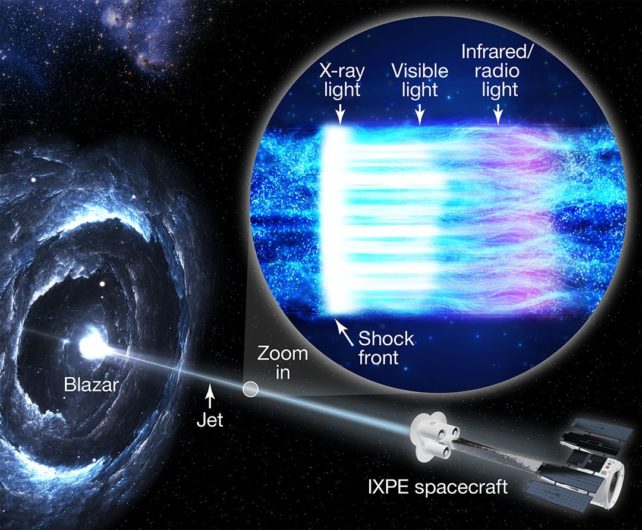For something that emits no light that we can detect, black holes just love to cloak themselves in radiance.
Some of the brightest light in the Universe comes from supermassive black holes, in fact. Well, not actually the black holes themselves; it's the material around them as they actively slurp down vast amounts of matter from their immediate surroundings.
Among the brightest of these maelstroms of swirling hot material are galaxies known as blazars. Not only do they glow with the heat of a swirling coat, but they also channel material into 'blazing' beams that zoom through the cosmos, shedding electromagnetic radiation at energies that are hard to fathom.
Scientists have finally figured out the mechanism producing the incredible high-energy light that reaches us from billions of years ago: Shocks in the black hole's jets that boost the speed of particles to mind-blowing velocities.
"This is a 40-year-old mystery that we've solved," says astronomer Yannis Liodakis of the Finnish Centre for Astronomy with ESO (FINCA). "We finally had all of the pieces of the puzzle, and the picture they made was clear."
Most of the galaxies in the Universe are built around a supermassive black hole. These mind-bogglingly large objects sit in the galactic center, sometimes doing very little (like Sagittarius A*, the black hole at the heart of the Milky Way) and sometimes doing a lot.
That activity consists of accreting material. A vast cloud assembles into an equatorial disk around the black hole, circling it like water around a drain. The frictional and gravitational interactions at play in the extreme space surrounding a black hole cause this material to heat up and shine brightly across a range of wavelengths. That's one source of a black hole's light.
The other – the one at play in blazars – are twin jets of material launched from the polar regions outside the black hole, perpendicular to the disk. These jets are thought to be material from the inner rim of the disk that, rather than falling toward the black hole, gets accelerated along external magnetic field lines to the poles, where it is launched at very high speeds, close to the speed of light.
For a galaxy to be classified as a blazar, these jets have to be almost directly pointed toward the viewer. That's us, on Earth. Thanks to extreme particle acceleration, they blaze with light across the electromagnetic spectrum, including high-energy gamma- and X-rays.
Exactly how this jet accelerates the particles to such high speeds has been a giant cosmic question mark for decades. But now, a powerful new X-ray telescope called the Imaging X-ray Polarimetry Explorer (IXPE), launched in December 2021, gave scientists the key to solve the mystery. It's the first space telescope that reveals the orientation, or polarization, of X-rays.
"The first X-ray polarization measurements of this class of sources allowed, for the first time, a direct comparison with the models developed from observing other frequencies of light, from radio to very high-energy gamma rays," says astronomer Immacolata Donnarumma of the Italian Space Agency.
IXPE was turned to the brightest high-energy object in our sky, a blazar called Markarian 501, located 460 million light-years away in the constellation of Hercules. For a total of six days in March 2022, the telescope collected data on the X-ray light emitted by the blazar's jet.

At the same time, other observatories were measuring the light from other wavelength ranges, from radio to optical, which previously were the only data available for Markarian 501.
The team soon noticed a curious difference in the X-ray light. Its orientation was significantly more twisted, or polarized, than the lower-energy wavelengths. And the optical light was more polarized than the radio frequencies.
However, the direction of the polarization was the same for all wavelengths and aligned with the direction of the jet. This, the team found, is consistent with models in which shocks in the jets produce shockwaves that provide additional acceleration along the length of the jet. Closest to the shock, this acceleration is at its highest, producing X-radiation. Farther along the jet, the particles lose energy, producing lower-energy optical and then radio emission, with lower polarization.
"As the shock wave crosses the region, the magnetic field gets stronger, and energy of particles gets higher," says astronomer Alan Marscher of Boston University. "The energy comes from the motion energy of the material making the shock wave."
It's not clear what creates the shocks, but one possible mechanism is faster material in the jet catching up to slower-moving clumps, resulting in collisions. Future research could help confirm this hypothesis.
Since blazars are among the most powerful particle accelerators in the Universe, and one of the best laboratories for understanding extreme physics, this research marks a pretty important piece of the puzzle.
Future research will continue to observe Markarian 501, and turn IXPE to other blazars to see if similar polarization can be detected.
The research has been published in Nature Astronomy.
